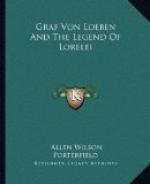[20] An idea as to the lack of action in this story
can be derived
from the following statement
by Otto (pp. 127-28), the brave hero:
“Was man Schicksale
zu nennen pflegt, habe ich wenige gehabt, aber
erfahren habe ich dennoch
viel und mehr als mancher durch seine
glAenzenden Schicksale erfahren
mag: nAemlich die FUehrungen der
ewigen Liebe habe ich erfahren,
die keinen verlAesst. und alles
herrlich hinausfuhrt.”
And then Siegenot, the other hero, says
that this is very true—whereupon
they embrace each other.
[21] The story was first published In Urania:
Taschenbuch fUer Damen
auf das Jahr 1818. pp. 305-37.
[22] Aside from the poems in Pissin’s collection
in the D.L.D. des
18. u. 19. Jahr.,
Ignaz Hub’s Deutschlands Balladen- und
Romanzen-Dichter, Karlsruhe,
1845, contains: (1) “Romanze von der
weissen Rose,” (2) “Der
Tanz mit dem Tode,” (3) “Der Bergknapp,”
(4) “Das Schwanenlied.”
“Loreley” is also reprinted here, with
modifications for the worse.
“Schau’, Schiffer, schau’ nicht
hinauf,” is certainly
not an improvement on Loeben’s “Lieb Knabe,
sieh’ nicht hinauf,”
[23] The following are common forms: “Nez,”
“zwey,” “versteken,”
“SfAeren,” “Saffo,”
“Stralenboten,” “Abendrothen.”
“Uebermuth,”
and so on, though the regular
forms, except in the case of
“Saffo,” also
occur.
[24] “Der Abend” reminds one strongly
of HOelderlin’s “Die Nacht,”
while “Tag und Nacht”
goes back undoubtedly to Novalis’ “Hymnen
an
die Nacht,” W. Schlegels
sonnet on the sonnet stood sponsor for
“Das Sonett,”
and Goethe and Tieck also reoccur in changed
dress. The poems on Correggio
(73), Ruisdael (75), Goethe (137),
Tieck (138-39), and Novalis
(141) sound especially like
W. Schlegel’s poems
on other poets and artists.
[25] In his Geschichte des Sonettes in der deutschen
Dichtung.’Leipzig,
1884. Heinrich Weltl (pp. 210-17) criticizes
Loeben’s sonnets most
severely from the point of view of content;
and as to their form he says:
“Blos die Form, oder gar die blosse
Form der Form ist beachtenswert.”
This is unquestionably a case of
warping the truth in order
to bring in a sort of pun.
[26] The triolett is worth quoting as a type of Loeben’s prettiness:
Galt
es mir, das sUesse Blicken
Aus
dem hellen Augenpaar?
Unter’m
Netz vom goldnen Haar
Galt
es mir das sUesse Blicken?
Einem
sprach es von Gefahr,
Einen
wollt’ es licht umstricken;
Galt
es mir, das sUesso Blicken
Aus
dem hellen Augenpaar.




